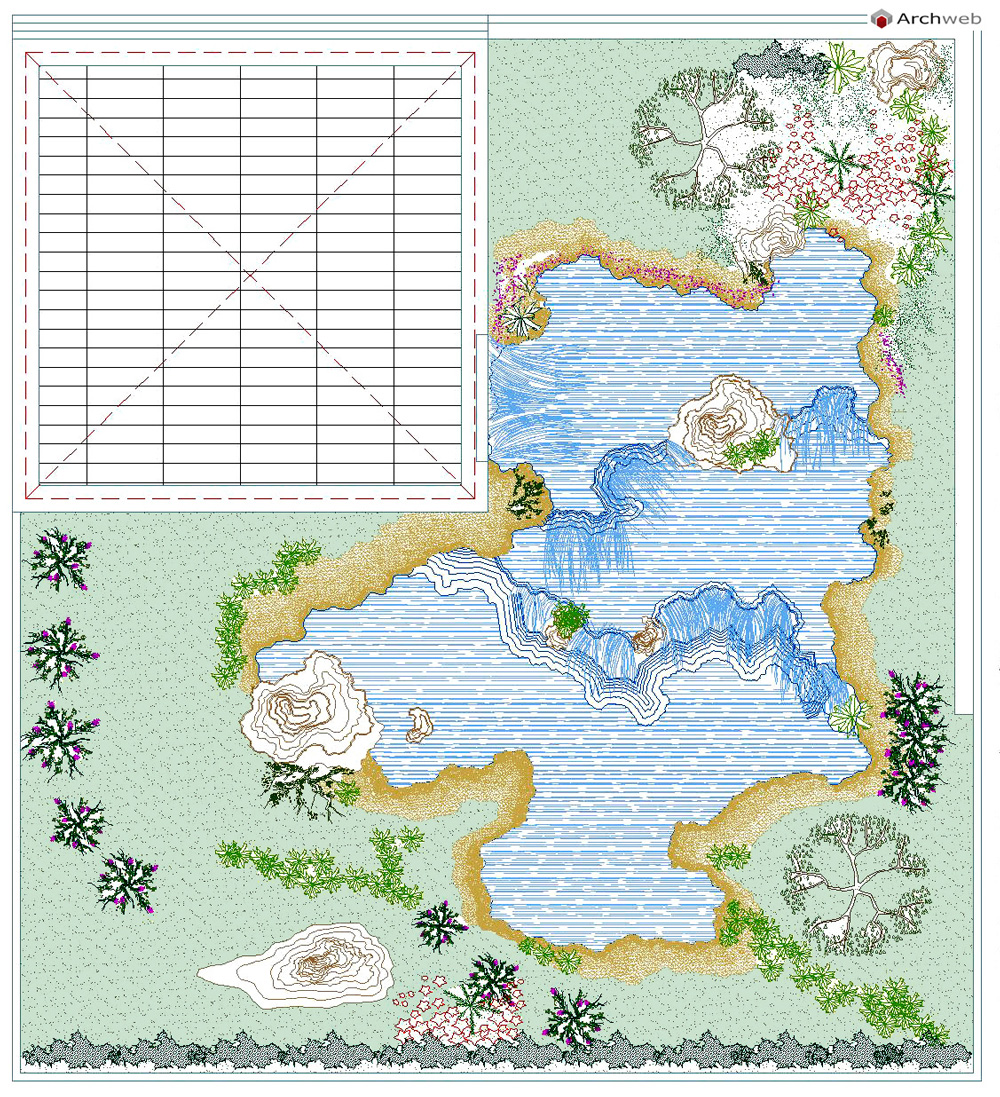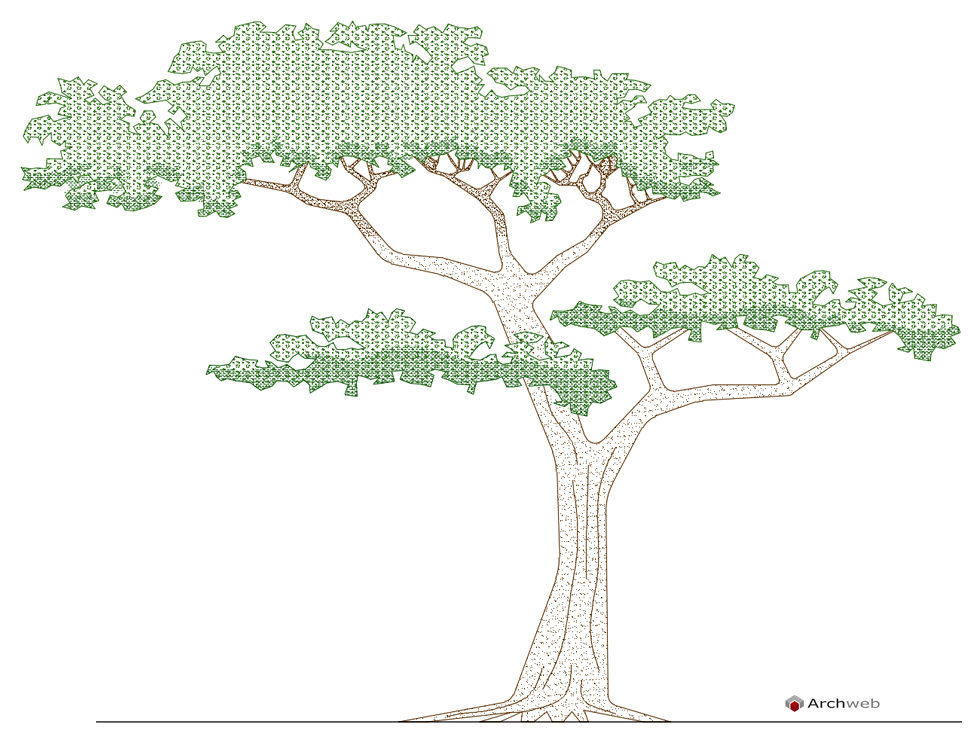Japanese garden: man and nature zen
Nature sustainability and attention to detail
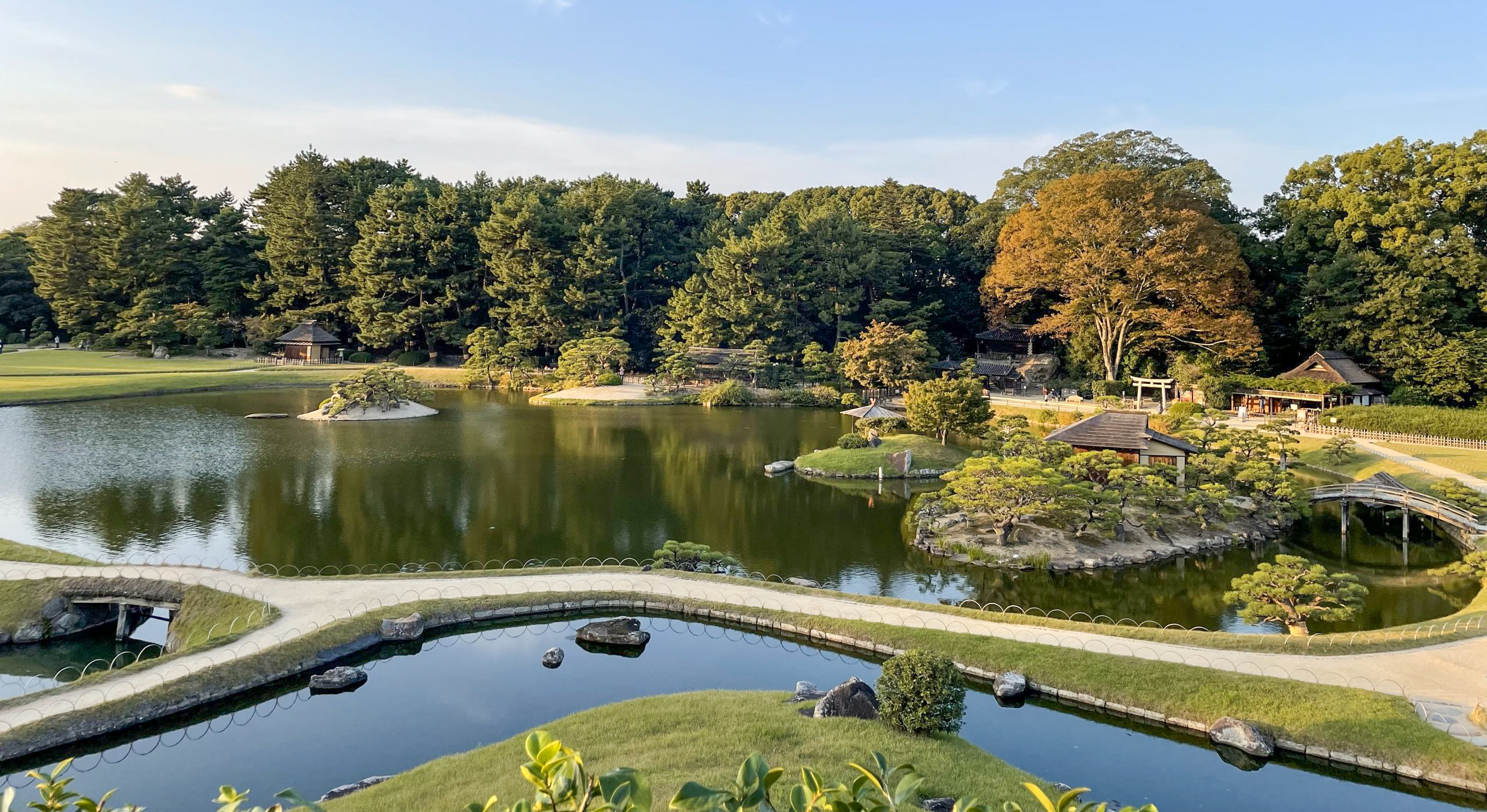
The Japanese garden represents the concrete example of the fusion between the anthropized aspect and nature. It is a space designed with quality and harmony, which boasts an ancient tradition worthy of note.
In fact, the extraordinary nature of Japan consists in its ability to guarantee high quality standards in everything that man creates.
From everyday objects to architectural artefacts, the craftsmanship and attention to detail are unique.
As with architecture, the designers conceive green urban space as a zen environment on a human scale, conceived to fit coherently into the context, with full respect for nature.
Let’s see then in this little trip to Japan, how art and garden are able to become a perfect union of the sacred and the profane.
Origins of the Japanese garden
Symbol of a deep-rooted culture, the characteristics of which are manifested in all its typologies, the Japanese garden presents itself in a very different way from that widespread in the West.
The origins of these green spaces, which have always been designed with care and dedication, date back to the 6th-7th centuries, during which the Asuka period developed, characterized by flourishing trade with China.
The first construction techniques that influenced the art of the Japanese garden came from China.
In the subsequent Heian period (8th-22nd century), new and more indigenous styles began to spread which made use of elements typical of the Japanese tradition.
Finally, it is with the Edo period that the art of the Japanese garden is enriched through the inclusion of elements from nature: bodies of water, stone bridges and green hills from which to admire the surrounding landscape.
Peculiarities of the Japanese garden
In Japan, meditation is an important component of daily life. For this reason, the garden is designed to be a Zen space suitable for practicing it, where mind and body can find refreshment.
To this end, it is common practice to study in detail each element that constitutes the green environment and insert it into the whole with a specific function and symbolic meaning.
Sinuous shapes, dimensional and shape contrasts, natural elements and essentiality prevail.
One of the aspects that characterizes the Japanese garden is the absolute respect for the environment and nature. This uniqueness manifests itself with the use of sustainable techniques and 100% eco-friendly materials.
To name a few, wooden pergolas and furnishings, flowerbeds with stones, stone storage solutions, wooden and rope protection systems.
Everything is ecological and there is no plastic or non-recyclable material.
Despite the different typologies, the garden in Japan is overall conceived to always include within it four natural elements considered fundamental since its origins.
Let’s see what they are.
ROCK
It is the first of the four elements of nature, fundamental to the Japanese garden and, in addition to being always present, it has a double meaning, symbolic and functional.
In fact, since its origins, the Japanese world considered the rock a sacred component, linked to divinity.
Today, stone gardens exploit rocks to compose paths, bridges, rest areas and also to build symbolic mountains and islands.
With the aim of creating these landscape components, we carefully proceed with the choice of stones, analyzing their dimensions, silhouette and colours, mainly chosen in dark tones.
Irregular shapes and imperfections are preferred, a tangible sign of the authenticity of this natural element.
The essential rule is to arrange the stones asymmetrically but forming a harmonious whole, so as to convey the idea of a natural and casual action.
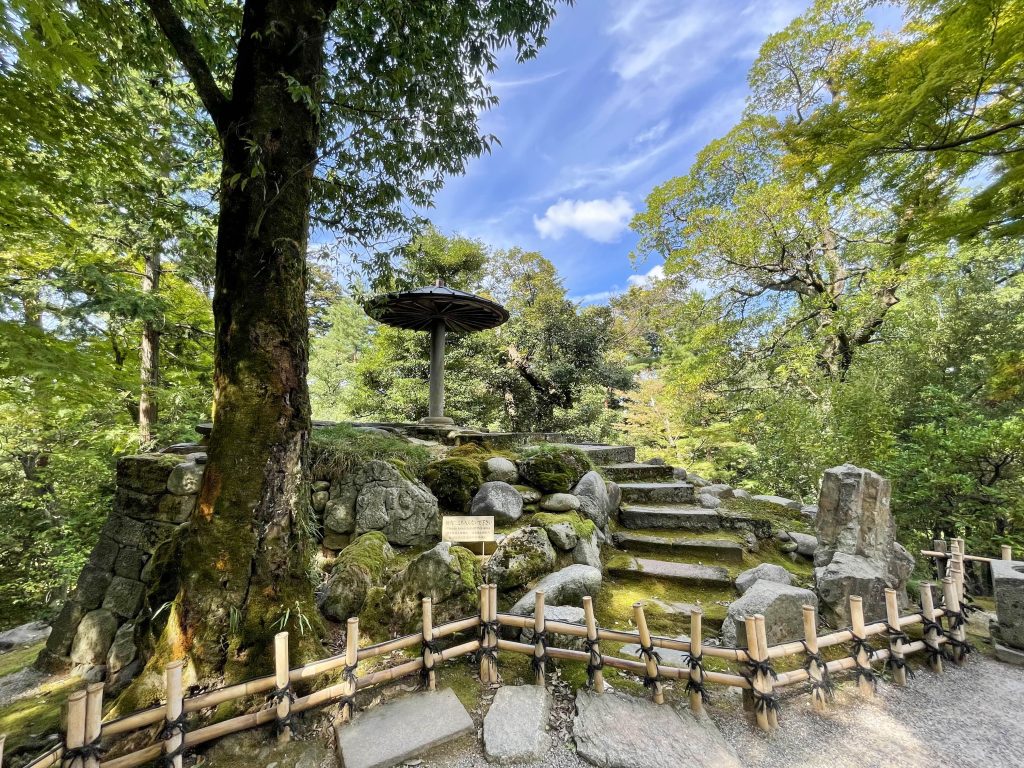
WATERFALL
Not always present, sometimes due to lack of supply, water is however considered an essential element in the garden.
For this reason, Japanese designers have introduced “karesansui“, gardens where water is not physically present but the idea of it, provided through the use of other elements.
Examples of this are the gravel paths that reproduce the flow of rivers and the rocky banks that emulate waterfalls.
If it is available, water is present in artificial lakes of varying dimensions, around which paths and hills are distributed from which to enjoy countless observation points.
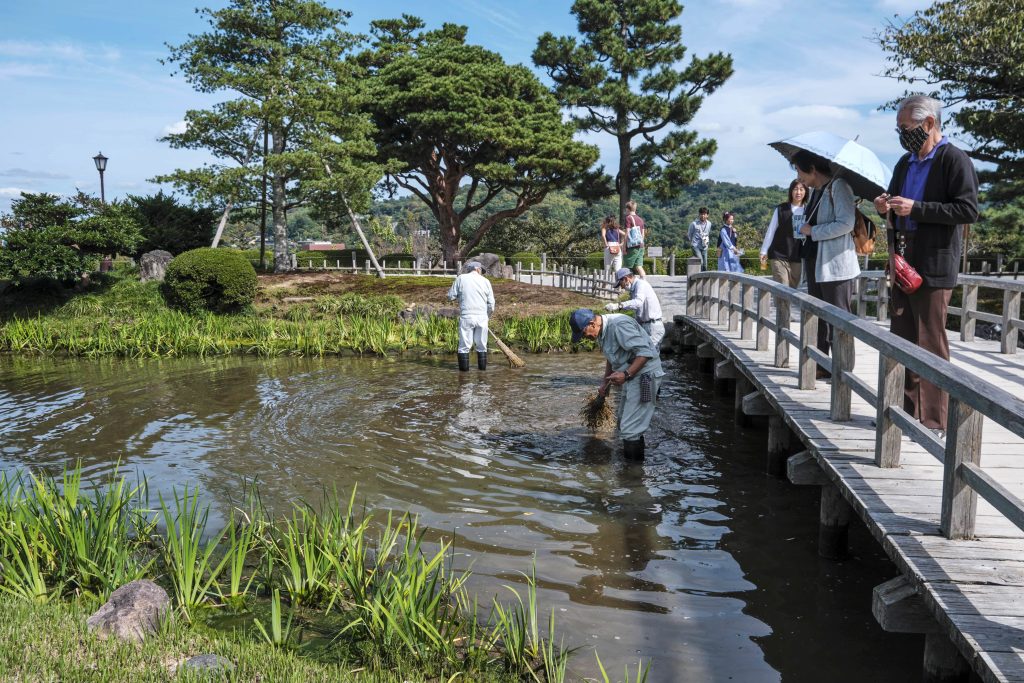
VEGETATION
It requires constant and meticulous maintenance by man in order to always be impeccable.
In fact, it is considerable how many people are responsible for managing meadows, waterways and vegetation, in order to constantly preserve the beauty and uniqueness of nature.
Depending on the season, the vegetation dresses the Japanese garden with a different appearance and colours, making it always fascinating.
In autumn orange prevails and warms the atmosphere, in winter the white snow makes the garden even more introspective and sacred, a true Zen place.
In spring, however, the color explodes with the blossoming of the cherry trees and in summer the green of the plants refreshes and purifies the surrounding air, transmitting a sense of peace and relief.
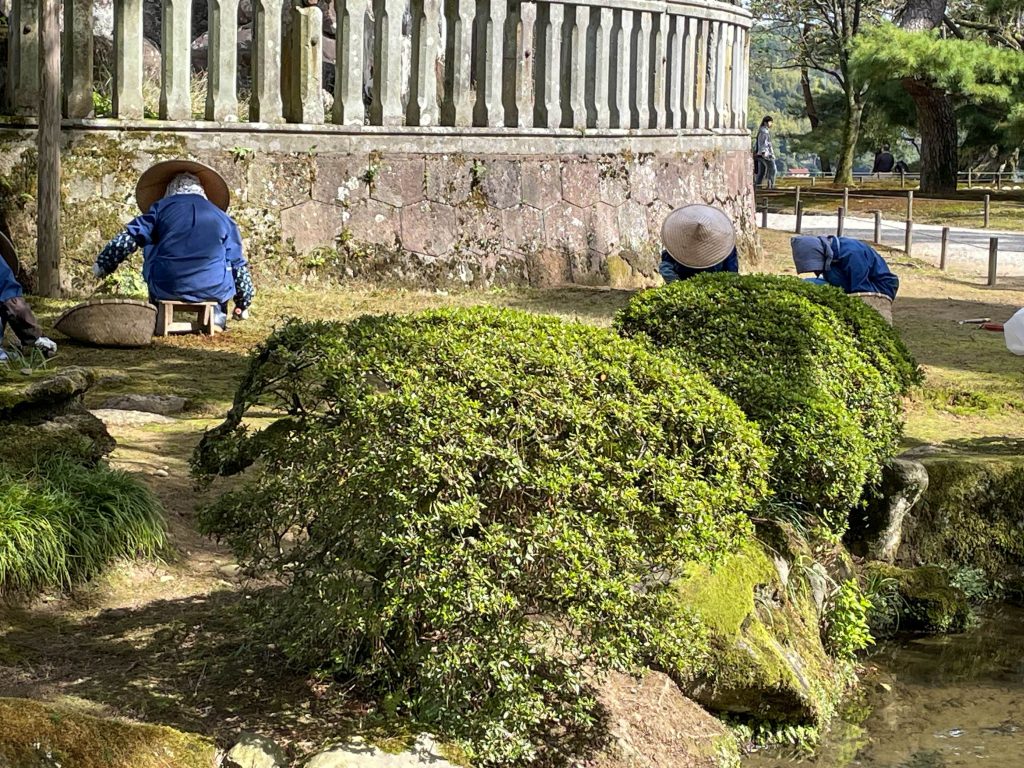
ELEMENTS OF THE LANDSCAPE
We have seen how natural elements play a very important function in this type of environment, both from a spiritual and practical point of view.
However, this is not the only component, since a series of landscape elements contribute to completing the green space, created by human hands but always with full respect for nature.
Examples of this are temples, lanterns, tea houses, birdhouses and many other devices used for specific purposes.
If you visit one of the famous gardens located in Japan, it will be usual to observe the stone lanterns. Introduced with the tea ceremony, they represented essential stages along the path that led to the tea house. Sometimes, these ornaments take on the appearance of real mausoleums, closely linked to the Buddhist religion.
One of the inevitable aspects of the Japanese garden is the relationship between man and nature which is recovered through contemplation. Thanks to the conception of the garden as a “zen space”, silence and sacredness prevail.
In fact, these are environments designed to be real sensorial journeys, capable of offering an immersion in nature. The only sounds to interrupt the silence are those of the flowing water and the rustling of the lush leaves.
Furthermore, maximum attention is paid to the exploitation of space with the aim of making it appear larger than it really is.
To this end, small bridges are often built from which to enjoy perspective views of the context or paths that take different and sudden directions. In fact, both solutions contribute to having the perception of larger and more varied areas.
To view an example of a Japanese garden in Italy and specifically in Rome click here
Koraku-en Japanese Garden, Okayama
This garden, located in Okayama Prefecture, dates back to the 1700s and is one of the few examples of a natural historic site. In fact, it preserves and offers visitors a collection of paintings belonging to the Edo period.
The park was created as a noble garden and then became public domain. Destroyed due to an air raid on Okayama during the Pacific War, it was rebuilt promptly thanks to the documents preserved in the Ikeda archive.
With a dual value, historical and aesthetic, it is counted among the three most valuable gardens in all of Japan.
Located along the bank of the Asahi river, it is characterized by a curvilinear shape and is surrounded by a lush green belt that extends along its entire perimeter.
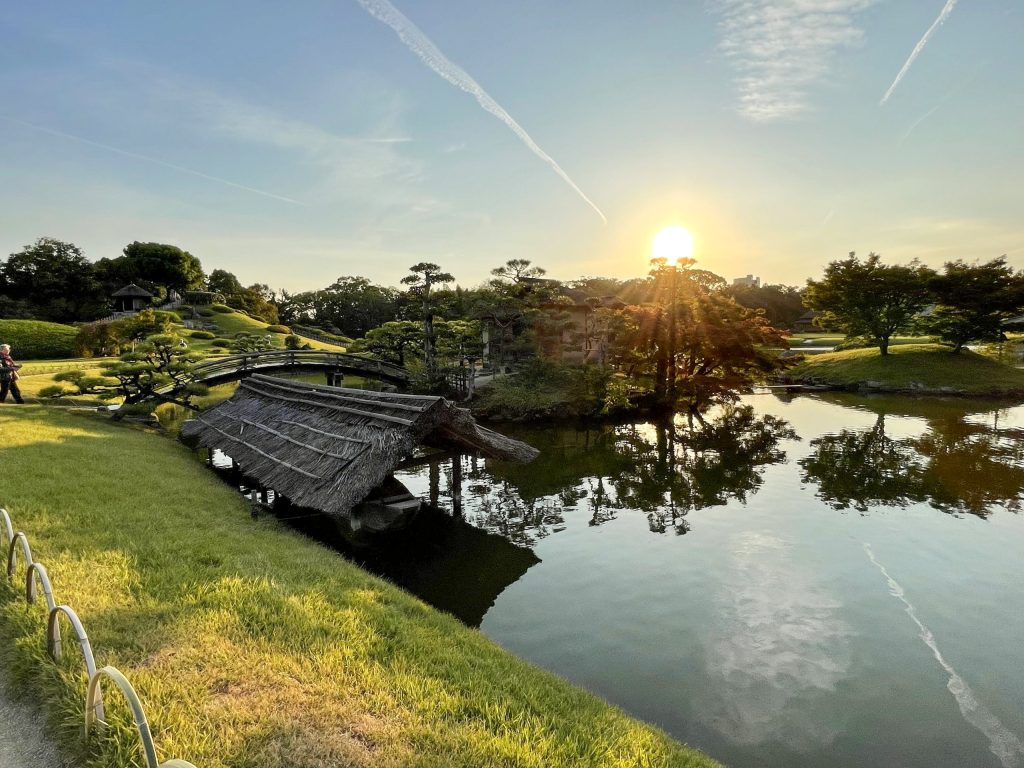
Over the course of history it has been the subject of continuous “restorations” which have led to the inclusion of numerous perimeter buildings and artificial groves and lakes, distributed in the central area and created to enrich the view.
The garden, built by the Japanese feudal lord Ikeda Tsunamasa, became a place of leisure for the nobles who could thus spend their free time in contact with nature.
Today, three lakes with sinuous shapes combine to make up the park, the largest of which is located in a central position. Along the edges there are some buildings of different sizes and surrounded by thick vegetation.
A hill rises in the center of the garden: once you reach the top it is possible to benefit from an overall view of the park and its scenic beauty.
In a mirror position, along the bank of the Asahi River, is Okayama Castle, which was the subject of restoration in the mid-1900s.
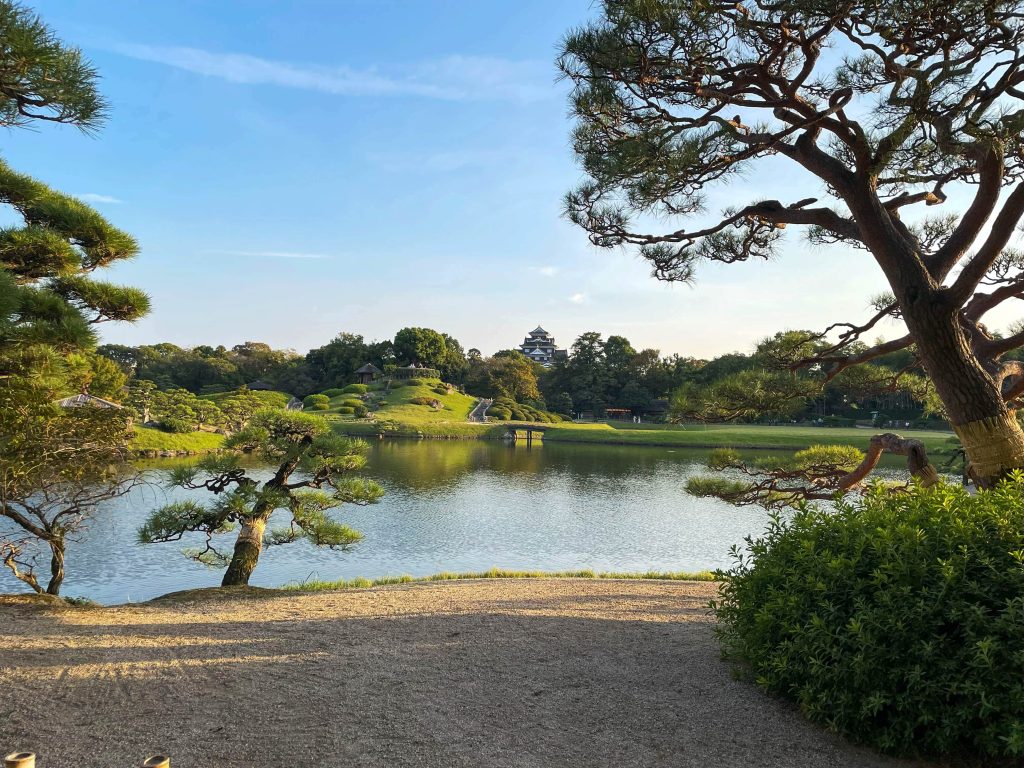
Kenroku-en Japanese Garden, Kanazawa
It is one of the most valuable gardens in Japan, dating back to the Edo period (1603-1868) and located in Ishikawa prefecture, also famous as the “garden of the six elements“.
In fact, six aspects were taken into consideration for the project: spaciousness, solitude, artifice, antiquity, waterways and panoramas.
It was originally conceived as a Japanese garden surrounding Kanazawa Castle and only later was it subject to continuous renovations and additions, until it now becomes a splendid complex with a very complex nature.
Anthropized aspects
Let’s now see what the artificial elements of the park are:
- Midori-taki waterfall: a faithful image of the natural ones, it flows into the pond on which it develops;
- Yugao-tei tea house: characterized by a large building, it was built in the mid-1700s;
- uchihashi-tei tea house: built entirely of wood, a portion of it is suspended over the water;
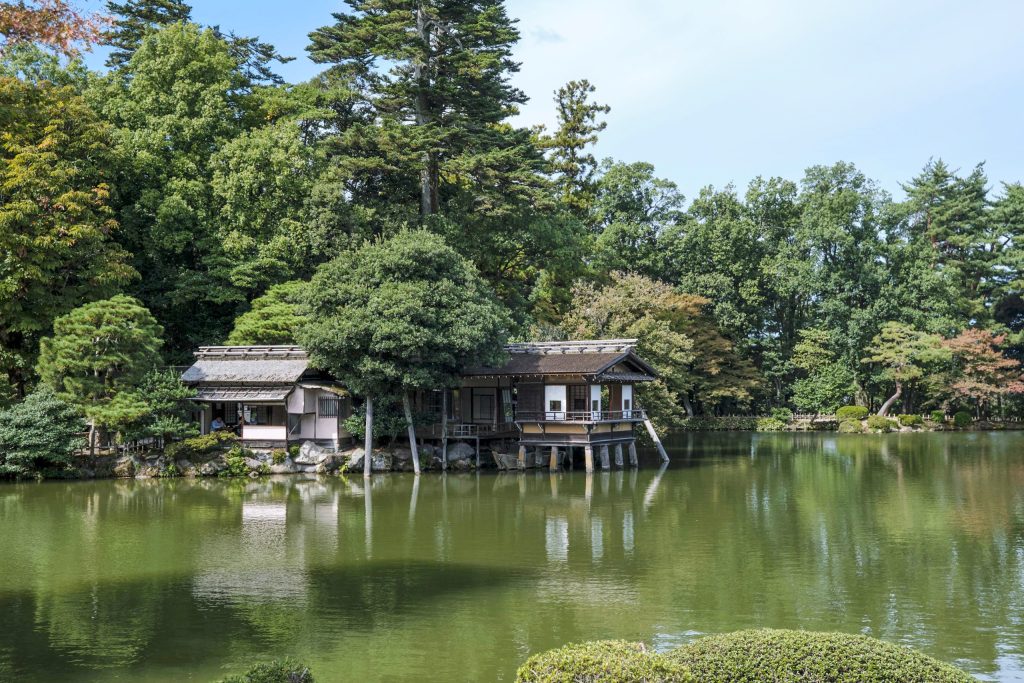
- Kotojitoro lantern: generously sized, this lantern is located along the Kasumigaike pond, characterized by a fountain with a 3.5 m high jet of water. It is a classic example of fusion between artifice and water;
- Meiji Memorial war memorial: along the perimeter of the garden, you come across this imposing bronze statue, a tribute to the heroic deeds of Prince Yamato Takero.
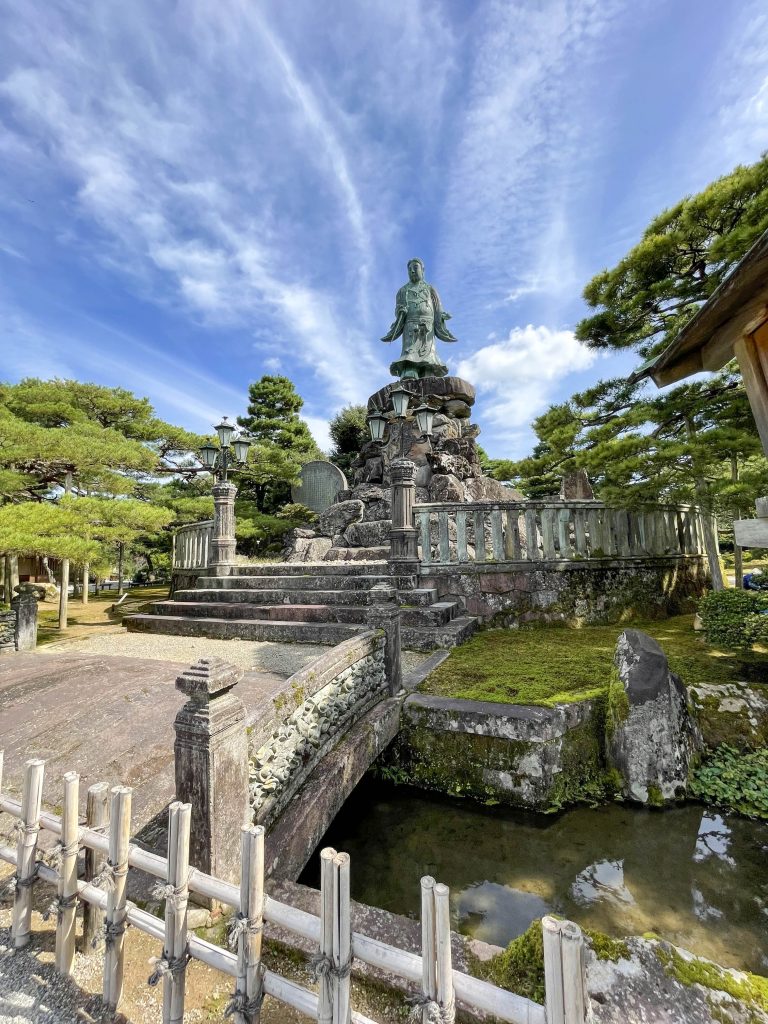
The yukizuri
A peculiarity that distinguishes this garden is represented by the appearance it takes on during the winter season.
In this regard, the Karasaki-no-matsu pine is the most majestic and famous shrub in the garden. In order to protect the branches from snow during the winter season, gardeners began to install “yukizuri“, a traditional Japanese protective system.
Composed entirely of ropes, the structure has a conical shape and stands over the entire length of the tree.
We start by planting the medium-large section bamboo poles, from which the ropes are stretched which protect the branches from the weight of the snow and the consequent collapse which would lead to their breaking. In addition to being a functional and very fascinating system to see in the Japanese garden, the yukizuri represents a ploy to protect nature while fully respecting it. In fact, this solution uses 100% eco-friendly materials. Sometimes, in winter, the ropes are illuminated and in the evening a spectacular scenario is recreated made up of installations that stand out in the snowy landscape.
Finally, it is important to point out how the structures are designed depending on the type of tree to be protected. The dimensions and type of elements that compose them vary according to specific needs, with a view to shaping themselves as an auxiliary element and not extraneous to the tree.
Sustainable solutions
As well as snow protection systems for tree branches, there are numerous solutions aimed at preserving the plant variety of the nature of Japanese gardens. One of the main objectives is to make them microcosms designed on a human scale with zero environmental impact.
An example of this is the supports for large tree species which risk dying over time.
In fact, when walking through urban parks, it is common to observe how, thanks to the sensitivity towards the ecosystem, trees are not cut down or protected with the aid of impact systems. In fact, only measures that are shaped by the natural environment are used.
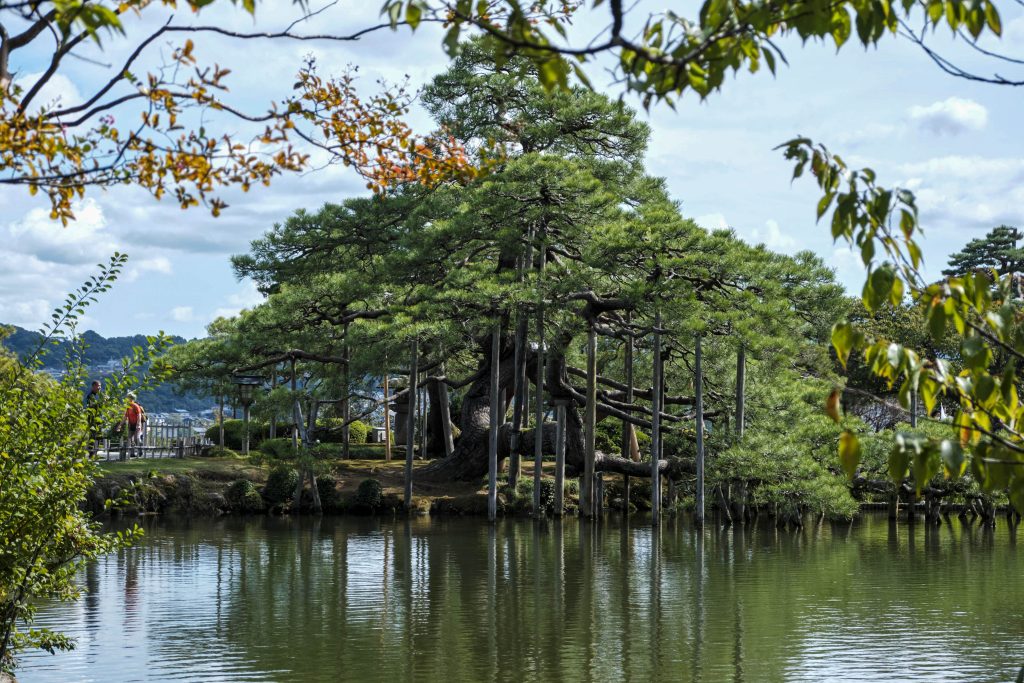
Even the furniture, walkways, fences and water drainage systems are all made of wood and stone and do not use non-recyclable materials.
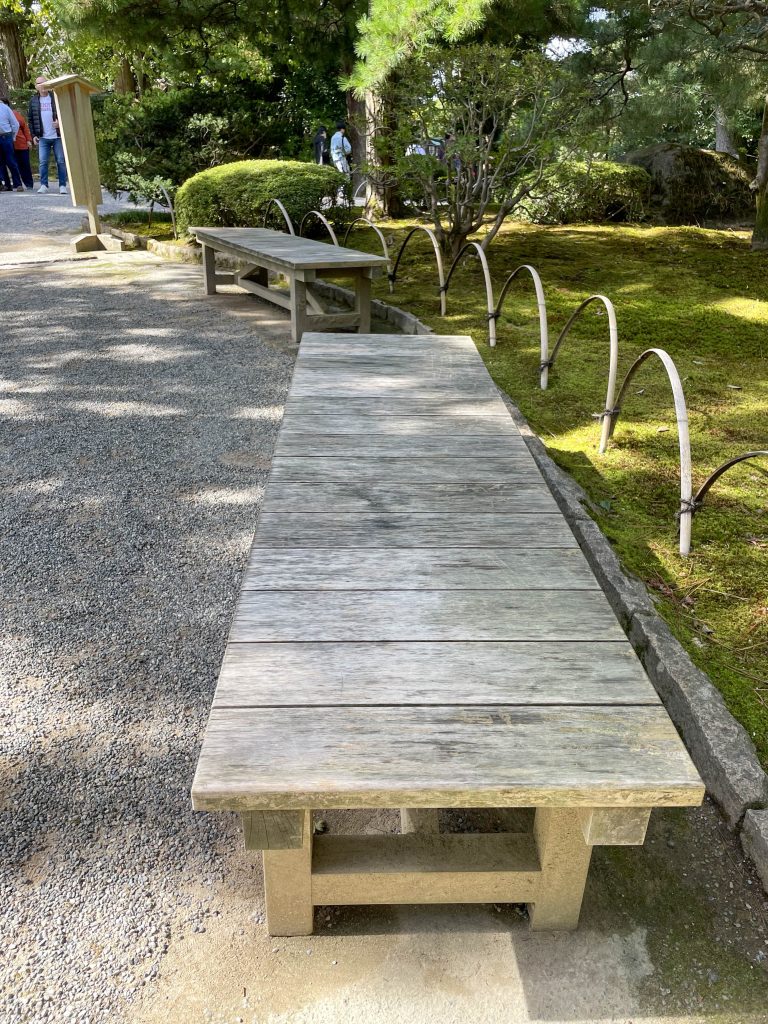
Photo © Chiara Del Core
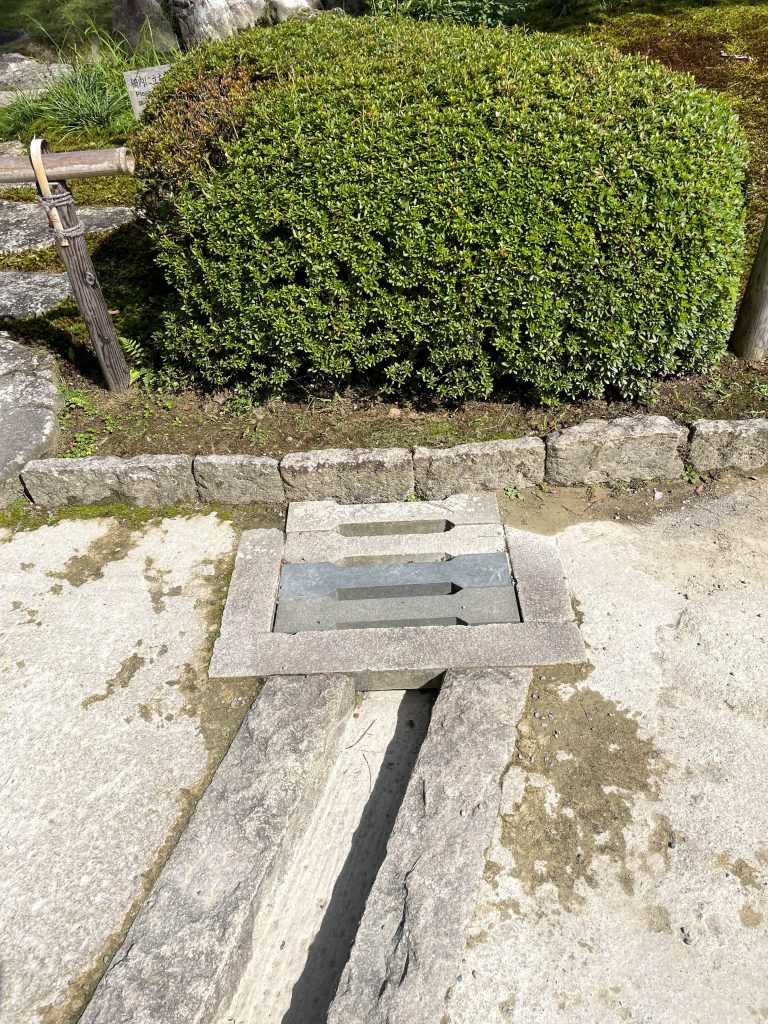
Photo © Chiara Del Core
To learn more about sustainable technologies and naturalistic engineering click here
If you are planning a trip to the Land of the Rising Sun, a visit to the Japanese garden is essential to immerse yourself in tradition and learn not only the design techniques, but also the spiritual value of these places and the sense of peace that they are capable of transmitting.
related cad blocks
DWG




























































